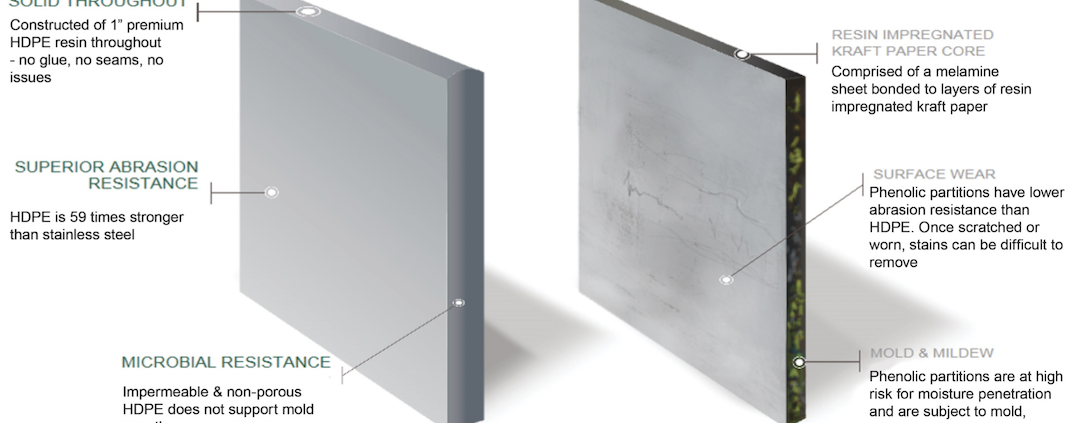Not All Bathroom Partitions Are Created Equally: The Differences Between Phenolic Core and Plastic (HDPE) Core Partition Materials
All bathroom partition materials are the same, right? It’s just a door and a privacy separator between stalls, so why should you even bother looking into partition materials?
These misguided ideologies about bathroom partitions make for poorly constructed commercial bathrooms and public gyms that are susceptible to many types of damage. In fact, the materials for your bathroom partitions do matter, and Scranton Products is here to show you why.
Two common materials for bathroom partitions are phenolic core and high-density polyethylene (HDPE) plastic core. While they may perform the same function, these materials are very different in their durability and longevity.
Let’s compare the two materials so you can see the differences between phenolic core and HDPE so you can make the right choice for your bathroom.
Material Construction
Phenolic bathroom partitions are built from resin-impregnated kraft paper. So the only thing keeping your partitions sturdy is tightly packed paper, which doesn’t sound particularly dependable.
HDPE plastic partitions, such as Scranton Products Hiny Hiders, are constructed with solid plastic color throughout. This high-density material makes for a strong, firm partition that will hold up against the various elements that can harm your bathroom partitions.
Mold, Mildew, and Germs
Bathrooms, on their own, are breeding grounds for all sorts of germs. But the high levels of moisture and humidity that build up also work to produce mold and mildew, which is harmful to your bathroom partitions and those who use the bathroom.
During a test by the American Society for Testing and Materials, a phenolic core bathroom partition began to grow mold after exposure to moisture only 21 days and grew high amounts after 28 days. This growth can be attributed to the kraft paper inside the partitions and its exposure to moisture. During the same test, an HDPE plastic partition experienced no mildew or mold growth in the 28-day period.
Impact Resistance Equals Expanded Longevity
The ability of bathroom partition material to withstand an impact makes for a longer-lasting partition that requires less maintenance over time. The difference in surface durability between phenolic core and HDPE plastic is vast based on the comprised material.
Because of HDPE’s plastic core throughout, it can resist abrasions and experiences less surface wear than phenolic core. So when you equip your bathrooms with HDPE partitions, they’re less likely to be impacted by dents or dings and will better resist scratches.
Don’t make the mistake of not looking into the materials used for your new bathroom’s partitions because there are drastic differences in their build that can lead to long-lasting, durable, and sanitary partitions or ones that lack in the three categories.
HDPE Hiny Hiders partitions from Scranton Products will stand up to the test of time and look great for as long as you use them. Learn more about where you can find Hiny Hiders partitions near you.




